Read Reviews
The Best Circular Saws
-
Best cordless circular saw - Makita DHS680Z Cordless Circular Saw
-
Most features for the money - Evolution Power Tools R185CCS Circular Saw
-
Best lightweight 18V circular saw - Ryobi R18CS7-0 ONE+ Cordless Brushless Circular Saw
-
Best corded circular saw - Makita HS7601J/2 Circular Saw
-
Best budget corded circular saw - HYCHIKA Corded Electric Circular Saw
-
Best budget corded circular saw option - Bosch PKS 55 Hand-Held Circular Saw
-
Best budget cordless circular saw - WESCO Cordless 18V Circular Saw
-
Best for depth of cut - Bosch Professional GKS 190 Circular Saw
-
Best compact 18V without brushless motor - DeWalt DCS391N-XJ Cordless Circular Saw
-
Best lightweight corded circular saw - DeWalt DWE560K-GB Circular Saw
Circular Saw Reviews
1. Makita DHS680Z Cordless Circular Saw
Best cordless circular saw
- Comparable power and performance with a corded circular saw but no wires to get tangled in
- The cast magnesium body is lighter than aluminium but just as strong, making it much easier to handle without compromising on sturdiness
- Automatic Speed Control automatically changes the cutting speed depending on the hardness of the material you’re cutting
- The rafter hook attached to the body is useful for storage as well as attaching to a tool belt
- Can cut up to a 50° angle
- The 57 mm cut depth gives you less range than most corded versions - every millimetre counts and more can make the job easier
- It’s expensive for a circular saw - unless cordless is an absolute priority, for most home DIYers it’s a bit excessive.
- Can't expect to run this circular saw all day on a single battery (even a heavy 6.0 Ah one) - the battery runs down quickly and requires charging often
- The grip is a bit small if you’ve got large hands - Makita say it's easy to operate with a gloved hand, but in reality the clearance between the handle and body feels tight
- Power
- Battery - 18V
- No-Load Speed
- 3,700rpm
- Blade Diameter
- 184mm
- Blades Supplied
- 1 X 24 TCT
- Cut Depth @ 90°
- 57mm
- Cut Depth @ 45°
- 41mm
- Bevel Capacity
- 50°
- Weight
- 3.3kg
- Design
- 4.5
- Performance
- 4
- Power
- 4
- Noise
- 4
- Safety
- 5
- Value for Money
- 4
If you’re keen to do away with cables and want a circular saw that’s relatively lightweight, this Makita DHS680Z ticks both of those boxes. It does pretty much everything you need it to and it’s an exciting and capable little saw.
I tested it out on constructional timber and made loads of cuts at both 0 and 45° bevels. I then tried cutting some hard English oak and used the included rip fence to cut along some softwood boards. On all accounts, it was an absolute joy to use. Even though this saw is incredibly light, the electronic speed control means you always have enough power to cut through what’s in front of you.
It might not have the biggest maximum cut depth at 57 mm, but you can extend the bevel to 50° and still tackle 37 mm thick timber. The powerful brushless motor spins the excellent Efficut 165 mm blade at a whopping 5,000 rpm, taking no time to get up to speed. The electronic brake stops it dead just as quickly when necessary.
Overall, this is a blindingly good saw; it punches way above its weight in terms of power. Plus, because it’s light, you can hang it off a rafter with the clever sky hook. Overall, it leaves an incredibly good finish on hard woods and I think this is hands down the best cordless circular saw on the market today.
Did you find this review helpful?
2. Evolution Power Tools R185CCS Circular Saw[ SAVE 38% ]
Most features for the money
- Multi-material circular saw - intended to cut through wood, metal and plastic without changing the blade
- The footplate is oversized, making the saw easy to keep in a straight line
- 3 metre power cord is quite a reasonable and useful length
- The cuts that it makes are relatively clean and smooth
- Extra handle helps have a bit more control over the weight of the saw
- Heavy duty and potentially difficult to handle - at just under 5 kg it’s not the sort of thing you want to take up a ladder with you
- The large motor on the left hand side can get in the way- you need to leave plenty of clearance when working with squeeze clamps which isn’t always ideal.
- The range of aftermarket circular saw blades available in 20 mm bore size is quite limited
- There’s no bag or case, nor much included in the way of accessories
- Power
- Mains - 1,600W
- No-Load Speed
- 3,900rpm
- Blade Diameter
- 185mm
- Blades Supplied
- 1 X 20 TCT
- Cut Depth @ 90°
- 64mm
- Cut Depth @ 45°
- 40mm
- Bevel Capacity
- 60°
- Weight
- 4.3kg
- Design
- 3.5
- Performance
- 4
- Power
- 3
- Noise
- 3.5
- Safety
- 4
- Value for Money
- 4
Sheffield-based Evolution power tools are a relatively new company when it comes to circular saws. Their budget-friendly saws and handy multi-material blades have gained them plenty of followers since they started back in 2002. Also, if you want to cut through more than just wood without changing blades, this is an option to consider.
The Evolution R185 CCS is rated to cut through wood, steel, aluminium, plastics, and other materials. However, I mainly tested it against timber: from CLS constructional timber to English oak that I milled myself, this big saw chewed its way through crosscuts and a few rip cuts too.
It’s got a massive 1,600 Watt motor and a huge 185 mm blade that spins round at 3,900 rpm. In general, nothing about this saw is subtle – it’s heavy, it’s noisy and it’s not the easiest to manoeuvre. It cuts through most things you put in front of it, but it takes its time and doesn’t leave a particularly good finish.
I suspect the main problem with this saw is that it’s trying to be a jack of all trades and ends up being a master of none. You’d think that such a big motor would sing through oak, but it’s slow.
Overall, I’d say that it’s not a bad saw for the money, but it’s pretty rough around the edges. Because it’s intended for more than just wood, it’s one of the best circular saws if you’re after a lot of features at this price point, but it has its flaws as a standard saw.
Did you find this review helpful?
3. Ryobi R18CS7-0 ONE+ Cordless Brushless Circular Saw[ SAVE 33% ]
Best lightweight 18V circular saw
- The Ryobi ONE+ battery system means you can use the same battery in your Ryobi lawn mower and cutting saw
- Brushless motor means not having to worry about changing brushes
- Not having a power cord makes a big difference - it feels safer and more versatile
- The rotating dust port makes attaching a dust extraction system much easier and helps keep the hose out of the way during use.
- Very light weight - weighs just 2.8 kg without the battery installed which is quite easy to handle
- The clear plastic blade guard is a weak point - it’s a vital safety feature but the plastic may break if you put the saw down too heavily
- The blade cuts on the right hand side of the motor, which makes keeping an eye on the cut line much more difficult if you’re right handed
- More expensive than the professional power tool brands like DeWalt and Makita yet you don’t see Ryobi power tools used on building sites
- Power
- Battery - 18V
- No-Load Speed
- 3,700rpm
- Blade Diameter
- 184mm
- Blades Supplied
- 1 X 24 TCT
- Cut Depth @ 90°
- 60mm
- Cut Depth @ 45°
- 42mm
- Bevel Capacity
- 50°
- Weight
- 3.2kg
- Design
- 3.5
- Performance
- 3.5
- Power
- 3
- Noise
- 3
- Safety
- 3.5
- Value for Money
- 3
The big, green power tool brand Ryobi have carved themselves out a legion of devoted fans – and they’re converting more DIYers every day! With a handy 18 Volt battery system and one of the best grips in the business, this Ryobi R18CS7-0 is a well-balanced and comfortable saw to use.
.
Putting this saw to the test against some constructional timber and English oak, I tried to make the tests as real-world relevant as possible. Most commonly, cuts with a circular saw will be parallel, but I also tried out plenty at a 45° angle too. Using the included rip fence, I cut along the grain of some big boards as well.
Even though this saw features a brushless motor, it seemed to struggle more than the other cordless saws when cutting. It worked well enough but wasn’t the overall best circular saw that I tried.
Nevertheless, sporting a big 184 mm blade, it can cut all the way down to 60 mm, which is quite a feat for a battery-powered tool. The 18 V system allows the blade to rotate at 3,700 rpm, and if you splash out for some of Ryobi’s High Energy batteries it will put out some serious cutting power.
There is another negative to mention though, and that’s the fact that it’s got far too many plastic parts for my liking – for this reason, I’m not sure if it’s made well enough to quite justify the price tag. It comes across as a decent saw let down by cheap parts.
In its favour though, it is easy to manage and one of the best lightweight rotary saws – which possibly wouldn’t be the case if it had more parts made of metal not plastic.
Did you find this review helpful?
4. Makita HS7601J/2 Circular Saw[ SAVE 3% ]
Best corded circular saw
- Makita’s attention to detail and build quality are very high compared to other companies
- The Makita MAKPAC storage system is a brilliant way to keep all your power tools safe and organised
- The adjustable-cutting-depth lever is easy to use and accurate
- Strong enough to saw through hard English oak
- The 66 mm cutting capacity gets the most out of the 190 mm saw blade size
- It’s quite a lot more expensive than some of the other circular saws on this list
- Safety switch isn't double sided which makes it a bit less user friendly
- It's relatively heavy and can get tiring after time
- The 2.4 m power cable is a bit short for a premium circular saw
- It's not possible to make bevelled cuts over 45°
- Power
- Mains - 1,200W
- No-Load Speed
- 5,200rpm
- Blade Diameter
- 190mm
- Blades Supplied
- 1 X 24 TCT
- Cut Depth @ 90°
- 66mm
- Cut Depth @ 45°
- 46mm
- Bevel Capacity
- 45°
- Weight
- 7.19kg
- Design
- 4.5
- Performance
- 5
- Power
- 4.5
- Noise
- 3.5
- Safety
- 4
- Value for Money
- 5
Makita’s HS7601J/2 Saw is a reliable workhorse favoured by professional tradespeople all over the UK. It doesn’t have tons of fancy features, and it’s not particularly light, but I still think it’s the most capable corded circular saw available right now.
Just like a tradesperson would, I put this circular saw through its paces on a variety of different woods. I blasted through constructional timber, hard English oak and ripped through metres of thick softwood boards. This saw is unbeatable! Side by side against any of the other saws on this list, it cuts the smoothest and takes the least effort to do so.
It’s not just a reliable and powerful saw though. It’s also the most capable, with a maximum cutting depth of 66 mm. The 1,200 Watt motor spins the 12-tooth MForce blade up to an extraordinary 5,200 rpm, which helps make the cuts so effortless.
The only three things that count against this saw are that it’s corded, that you can’t make bevelled cuts over 45°, and that the safety switch isn’t double-sided. For a saw that’s used so much in the real world, these factors are a little disappointing – they make it just a touch harder to use.
Also, at first, I thought this saw was a bit heavy. It is quite weighty, but this does seem to be because all the parts are high quality and made to last.
If I was only reviewing corded tools, this would easily win as the best circular saw overall – but when compared against cordless models it does have the downside of tethering you to a power supply.
It comes in one of Makita’s useful MAKPAC boxes, which makes it easy to store, and it glides through all sorts of timber with ease. Overall, it’s very easy to use and I think it’s the best corded circular saw you can buy right now. A real pleasure to use!
Did you find this review helpful?
5. HYCHIKA Corded Electric Circular Saw
Best budget corded circular saw
- Compared with the Evolution R185 CCS, this saw cuts deeper at both 0 and 45°. If you’re planning to cut through thick timbers, it’s an excellent choice of saw.
- The laser guide is a handy way to keep on your cut line. It means you can look further forward along your pencil mark or chalk line when cutting free hand.
- If you’re going to use a corded power tool, it needs a long lead! I like the 3 metre one on this saw, it’s long enough to use on sheet materials without needing the extension cord.
- Having two blades included in the purchase price means two things. Not only can you make fine as well as rough cuts, but you’re putting less wear on each blade, so they last for longer.
- It’s heavy. At 4 kg, it’s almost the heaviest on my list. Although it’s good for keeping the saw flat on the workpiece, it’s a bit unwieldy if you try to use it any other way.
- Once you’ve used a cordless circular saw, it’s quite hard to go back to a corded one. Even with three metres of cord to play with, you need to keep an eye on where it is during use.
- The position of the dust extractor port fires everything right back at your trousers. And because it doesn’t include a dust bag, there’s no way to avoid getting dusty.
- Power
- Mains - 1,500W
- No-Load Speed
- 4,700rpm
- Blade Diameter
- 190mm
- Blades Supplied
- 1 X 24 TCT, 1 X 40 TCT
- Cut Depth @ 90°
- 65mm
- Cut Depth @ 45°
- 45mm
- Bevel Capacity
- 45°
- Weight
- 4.0kg
- Design
- 4
- Performance
- 4
- Power
- 4
- Noise
- 3.5
- Safety
- 4
- Value for Money
- 5
This isn’t the first time I’ve tested out HYCHIKA power tools, and I’ve been pleasantly surprised by this budget brand before. They make solid and inexpensive kit that performs well without being too expensive. The same is the case for their 1,500 Watt corded circular saw. It’s a decent corded saw with a powerful motor, laser guide, and impressive cutting depth.
Starting with the ergonomics, this is a comfortable saw to hold, with a TPE-coated rear handle and chunky front grip. It’s like the Evolution saw, a bit on the heavy side but well-balanced. There’s an ambidextrous safety switch and a large two-finger trigger that’s comfortable to use as well. It’s good to see that the blade guard is made of aluminium and that the bottom plate is reasonably thick.
The onboard 1,500 Watt motor can spin up the large 190 mm blade to an impressive 4,700 rpm in a second or two, and to tackle rough cuts and finer work, they’ve thrown in a pair of blades. There’s a 24-tooth and a 40-tooth TPI included in the set.
You can quickly change the bevel angle from 0 – 45° and dropping the blade down to a maximum cut depth of 65 mm at 0° is no problem either. The cut depth reduces to 45 mm at 45° bevel, but it’s still enough for sheet materials and some dimensional timbers. Overall, this is an impressive corded circular saw for the money. It might lack some refinement, but for budget-conscious DIYers, it’s hard to beat.
Did you find this review helpful?
6. Bosch PKS 55 Hand-Held Circular Saw[ SAVE 14% ]
Best budget corded circular saw option
- Cuts well through both softwood and hardwood
- Good value option when comparing cost and performance
- Cutting depth of up to 55 mm is hard to find in quality tools in this price range
- Relatively straightforward for people with limited DIY experience to get the hang of
- Aligning the cut line with the cutting guide can be difficult because the guide is sometimes hard to see
- No dust box or dust-catching feature supplied
- More effort is required to push the saw through wood than with others featured on this list
- Power
- Mains - 1,200W
- No-Load Speed
- 5,600rpm
- Blade Diameter
- 160mm
- Blades Supplied
- 1 X 18 TCT
- Cut Depth @ 90°
- 55mm
- Cut Depth @ 45°
- 38mm
- Bevel Capacity
- 45°
- Weight
- 3.9kg
- Design
- 5
- Performance
- 3
- Power
- 3.5
- Noise
- 3
- Safety
- 4
- Value for Money
- 4.5
Anyone who’s ever dabbled with DIY tools will be familiar with the ‘Bosch’ name. Known for their innovative engineering and capable kit, there are two main lines of Bosch tools – green for DIY, and blue for professional use. The Bosch PKS 55 resides in their “green” line. It’s not a professional saw, but it’s still one that every DIYer will find useful in their toolkit.
When testing, I made the same series of cuts through softwood and hardwood as I did with the other saws – at both 0 and 45° bevels. Then I tried out the rip fence and took the ends off some big softwood boards.
Like the name suggests, this circular saw can cut down to a depth of 55 mm. The 1,200 W motor spins the 160 mm Bosch Speedline wood blade at an impressive 5,600 rpm – these are all impressively good stats for a saw of this price.
Although the finish wasn’t the best, and it took a bit more effort to push the saw through the wood, it’s incredibly good value for money. I’m also a huge fan of Bosch’s CutControl system- it makes freehand cuts a lot more accurate. As a result, this is probably the best budget circular saw on the market right now. Sure, it has its downfalls, but it also offers a lot for the price.
Did you find this review helpful?
7. WESCO Cordless 18V Circular Saw
Best budget cordless circular saw
- Cordless power tools are a game changer, especially at this price. You don’t need to keep an eye on dangerous training power leads, and you can work comfortably off-grid with one.
- The 4.0 Ah battery is powerful enough to get a decent amount of work out of the saw on a single charge. And because you get a power level indicator, you know when it’s dead!
- I think it’s great that they’ve included a pair of 24 tooth carbide-tipped blades. I can’t vouch for their quality, but having a spare blade is always a good thing.
- For the price, this is an impressive saw for cutting through sheet materials without worrying about the thermal cut-out kicking in. It’s easy to attach to a dust extractor as well.
- The depth adjustment mechanism is poorly designed and not strong enough in my opinion. Instead of a standard wing nut, WESCO have opted for a wobbly piece of plastic.
- One of the big disadvantages of battery powered tools is downtime when the battery runs out. To get the most out of a tool like this, you’ll need to buy spare batteries.
- Apart from the cardboard box this saw is delivered in, there’s no case to keep it safe. This saw is vulnerable to knocks and drops, especially due to the plastic safety guard.
- Power
- Battery - 18V
- No-Load Speed
- 4,000rpm
- Blade Diameter
- 165mm
- Blades Supplied
- 2 x 24 TCT
- Cut Depth @ 90°
- 53mm
- Cut Depth @ 45°
- 36mm
- Bevel Capacity
- 45°
- Weight
- 3.2kg
- Design
- 3.5
- Performance
- 3.5
- Power
- 4
- Noise
- 4
- Safety
- 4
- Value for Money
- 4
The impressive range of cordless tools made by WESCO is increasing all the time. They make useful battery-powered kit for the home and garden, as well as this powerful cordless 18 Volt cordless circular saw. It’s well priced for a cordless power tool like this and comes with a decent-sized 4.0 Ah battery and a pair of blades.
Design-wise, the look and feel of this saw reminds me of Makita without some of the refinements. There’s a decent amount of TPE on both handles, the trigger feels good, and you can operate the safety switch with either hand. It’s a shame that the blade guard is made from clear plastic though as I can’t see this lasting through more than a few knocks and drops.
The maximum cut depth at 0° is 53 mm, and just 36 mm at 45°. The 20 Volt battery system spins the 24-tooth 165 mm diameter blade up to 4,000 rpm quickly, and the electronic brake stops it again to conserve battery and keep things safe. It’s light enough for one-handed operation and because it’s cordless you can use it wherever it’s needed.
Did you find this review helpful?
8. Bosch Professional GKS 190 Circular Saw[ SAVE 7% ]
Best for depth of cut
- A seriously powerful circular saw from one of the best names in the industry.
- The overall build quality is second to none, as you’d expect from Bosch’s “blue” range. Everything is chunky and well-engineered.
- The die cast aluminium saw blade guard is robust and should last for as long as the tool itself.
- With a maximum cut depth of 70 mm at 90°, you won’t often have to cut materials from both sides to make it all the way through, and 50 mm at 45° is equally impressive.
- The saw comes in a large, robust hard plastic carry case. It’s a real bonus and will keep the tool safe and clean when not in use.
- The blade is mounted to the right of the motor, making the cut line harder to see if you’re operating it with your right hand.
- It’s a real shame that the GKS 190 isn’t compatible with a rail system because they really improve the performance and scope of what you can do with one of these tools.
- The bevel angle adjuster is held with a wing nut, rather than a quick-release cam. It’s a pain if you want to fine tune an angle or change it often.
- More than 4 kg for a corded circular saw is on the heavy side, even if the cut depth is impressive.
- Power
- Mains - 1,400W
- No-Load Speed
- 5,500rpm
- Blade Diameter
- 190mm
- Blades Supplied
- 1 x 16 TCT
- Cut Depth @ 90°
- 70mm
- Cut Depth @ 45°
- 50mm
- Bevel Capacity
- 56°
- Weight
- 4.2kg
- Design
- 5
- Performance
- 4.5
- Power
- 4.5
- Noise
- 4
- Safety
- 4
- Value for Money
- 3.5
The Bosch GKS 190 comes from Bosch’s Professional (aka “Blue”) range of tools, and is aimed towards the higher end of the market.
This is a well designed and constructed, powerful (at 1400 Watts the most powerful in its class) heavy duty electric saw made with highly robust components. It weighs slightly more than similar models from other manufacturers, but it’s nicely balanced and comfortable to hold. The handles are well-moulded, and the controls are well laid out, making it easy to use.
The blade can rotate up to 5,500 rpm (no-load speed) and can cut down to a depth of 2.8″ (70 mm) at 90° and 2″ (50 mm) when adjusted to a 45° angle. Bevel capacity is an impressive 56 degrees.
The cutting process is exceptionally smooth and the cuts themselves are precise and true, whether using the default vertical setting, setting the baseplate to the required angle, or using the solid guide rail.
The cutting operation is also aided by a dust blower that maintains visibility of the cutting line and a wood chip deflector. A well-insulated long power cord and a well-made plastic case are handy extras as well.
If you are looking for the best circular saw for professional tasks this might be just the ticket.
Did you find this review helpful?
9. DeWalt DCS391N-XJ Cordless Circular Saw[ SAVE 16% ]
Best compact 18V without brushless motor
- Low noise and vibration levels make it comfortable to use for long periods
- The rubberised grip and front handle are very comfortable and it is easier to manage awkward cuts too
- The cast magnesium base and blade housing are lightweight, rigid, and rust-proof - the overall feel is long-lasting quality
- The electronic brake makes this one of the safest circular saws you can buy- the blade stops almost immediately when you release the trigger which avoids potentially dangerous overruns
- The included 24-tooth carbide tipped blade is surprisingly good and leaves a nice thin kerf
- Some users have had problems with the safety switch during use - it’s quite easy to slip off the switch and lose power during a cut
- No case, battery, or charger come included - this is just the bare unit
- With a cutting capacity of only 55 mm, there’s quite a lot you can’t do with this circular saw unless you cut from both sides
- Power
- Battery - 18V
- No-Load Speed
- 5,150rpm
- Blade Diameter
- 165mm
- Blades Supplied
- 1 X 24 TCT
- Cut Depth @ 90°
- 55mm
- Cut Depth @ 45°
- 42mm
- Bevel Capacity
- 50°
- Weight
- 3.2kg
- Design
- 3
- Performance
- 5
- Power
- 3.5
- Noise
- 4
- Safety
- 4
- Value for Money
- 4.5
One of the most respected big tool brands, DeWalt are known for their quality saws. There was a lot riding on this little beast, and I was blown away by how well it coped with all sorts of jobs. The DCS391 is another excellent bit of kit in DeWalt’s range of cordless tools.
I put it to work cutting plenty of CLS, just as any DIYer or professional would, making lots of cuts at 0° and more than a few at 45° as well. I tried the same on some hardwood and then made some difficult long rip cuts as well. I have to say, there’s one thing that this saw does well and that’s make smooth cuts. It felt like it had power in spades, and I always had complete control.
Although this saw only has a brushed motor, it’s still very capable. The maximum cut depth of 55 mm could have been a bit more, but you can still increase the bevel to 50° when you need it. The included DT1209 blade didn’t make for the cleanest cutting, but it was very sharp and excelled at rip cuts.
This might have been the best circular saw that I tested out had it not been for the odd position of the dust extractor hose and some hard-to-read angle markings. I’m splitting hairs though really because it’s still one of the best cordless ripping saws I’ve ever tried, plus it’s compact to boot.
Did you find this review helpful?
10. DeWalt DWE560K-GB Circular Saw
Best lightweight corded circular saw
- DeWalt are one of the best names in the business, and for good reason. You’ll find the DWE560K-GB on building sites across the country.
- The 1350 Watt motor gives you reliable power for quicker and easier cuts.
- The body is seriously tough and durable, I expect this saw to last for years of heavy use
- The Internal dust blower keeps the cut line visible, even when you’re not using an extractor setup.
- The included 24-tooth blade is ideal for heavy duty sawing jobs and it’ll stay sharp for ages.
- Putting the saw back in the case is awkward - it’s a tight fit and must go back in a specific way.
- If you’re a light DIY user, you’ll be hard-pressed to justify spending this much money on a circular saw when there are cheaper options available.
- A 16 mm bore diameter isn’t the most common size, so make sure you buy the right replacement.
- The saw blade isn’t ideal for fine work and can make a mess of surfaces if you’re not careful.
- Power
- Mains - 1,350W
- No-Load Speed
- 5,500rpm
- Blade Diameter
- 184mm
- Blades Supplied
- 1 X 24 TCT
- Cut Depth @ 90°
- 65mm
- Cut Depth @ 45°
- 42mm
- Bevel Capacity
- 48°
- Weight
- 3.7kg
- Design
- 4
- Performance
- 4
- Power
- 4
- Noise
- 4
- Safety
- 4
- Value for Money
- 3.5
One of the most reliable and well-built circular saws is the DeWalt DWE560K. It’s always a competition between them and Makita, and of course both brands are extremely reputable and preferred by professionals.
The DWE560K is compact and lightweight (3.7 kg) yet robust, and despite its powerful motor (that generates a no-load speed of 5,500 rpm) it delivers an extremely smooth, controlled, least noisy and least vibrating cutting experience. This really is one of the best electric saws around.
The nicely positioned depth adjustment level and the neat angle locks allow you to easily adjust the base plate and cuts can be made to a depth of 2.5″ (65 mm) at 90 degrees and 1.6″ (42 mm) at 45 degrees.
The integrated dust blowing mechanism and the cutaway lower saw guard both ensure a clearer view of the cut line resulting in a more accurate cut.
Another neat feature is DeWalt’s patented AirLock system that hooks up to the dust extraction port at the rear of the saw and ensures efficient removal of dust and debris.
Other plus points for this power saw are a 24-tooth blade that’s ideal for rough cutting (the HS7601J/2 comes with a 12-tooth blade), a long power lead and a heavy duty carry case.
Did you find this review helpful?
Product Tester
To find the ideal circular saw for your needs, you need someone to test some of the top models – this is what I have done. I rigorously evaluated various circular saw models to ensure that you can confidently make the right choice for you. The testing process covered various key aspects:
- Design: The best circular saws are ergonomic, durable, and easy to handle. So, when considering each model’s design, I evaluated the tool’s weight, build quality, grip comfort, and overall ergonomics. Models that were made from high-quality materials, such as high-carbon steel or high-speed steel blades, were rated highest. Mains-powered models had to have a power cord of at least 3 m, and battery-powered models needed to have a brushless motor.
- Performance: I tested the circular saws out on a range of woods, including constructional timber, English oak, and softwood boards, as well as other materials like steel, plastics, and aluminium. I assessed each model’s cutting depth, deeming anything below 60 mm not versatile enough to get the highest marks in this category.
- Power: When testing power, I assessed the watts of each model – those above 1500 watts were rated higher, as this power enables the user to complete a wider variety of tasks. I took into consideration the power differences between mains-powered and battery-powered models. I tested the amperage or horsepower rating of each motor, as well as the variable speed controls. I looked out for features like electronic speed control, as this helped to improve the versatility of the tool. An RPM of at least 4,000 is a must for the average user, so any models below this were marked down.
- Noise: Given that prolonged exposure to noise levels around 85 dB is not recommended, circular saws that exceed 90 dB in noise output received lower ratings in our evaluation.
- Safety: For a circular saw to be safe, it needs to combine several safety features. An electronic break, blade guard, and accessible safety switch are all important to ensure the user’s safety. I factored whether these features were present into my tests, as well as how effective these were. For example, blade guards made from sturdy material were given higher marks than those made from flimsy plastic. Features such as anti-kickback pawls, a dust collection system, and overload protection were given the highest ratings.
- Value for Money: My evaluation of each model’s value for money was based on its overall performance, range of features, and the effectiveness of its design. I also took into consideration factors such as whether blades were supplied and whether the product was in what I deemed the “affordable” bracket for most households.
Compare Product Features
Use the dropdown to sort the table by the feature you want to see.
Makita DHS680Z Cordless Circular Saw
- 4.3
- Battery - 18V
- 3,700rpm
- 184mm
- 1 X 24 TCT
- 57mm
- 41mm
- 50°
- 3.3kg
Evolution Power Tools R185CCS Circular Saw
- 3.7
- Mains - 1,600W
- 3,900rpm
- 185mm
- 1 X 20 TCT
- 64mm
- 40mm
- 60°
- 4.3kg
Ryobi R18CS7-0 ONE+ Cordless Brushless Circular Saw
- 3.3
- Battery - 18V
- 3,700rpm
- 184mm
- 1 X 24 TCT
- 60mm
- 42mm
- 50°
- 3.2kg
Makita HS7601J/2 Circular Saw
- 4.4
- Mains - 1,200W
- 5,200rpm
- 190mm
- 1 X 24 TCT
- 66mm
- 46mm
- 45°
- 7.19kg
HYCHIKA Corded Electric Circular Saw
- 4.1
- Mains - 1,500W
- 4,700rpm
- 190mm
- 1 X 24 TCT, 1 X 40 TCT
- 65mm
- 45mm
- 45°
- 4.0kg
Bosch PKS 55 Hand-Held Circular Saw
- 3.8
- Mains - 1,200W
- 5,600rpm
- 160mm
- 1 X 18 TCT
- 55mm
- 38mm
- 45°
- 3.9kg
WESCO Cordless 18V Circular Saw
- 3.8
- Battery - 18V
- 4,000rpm
- 165mm
- 2 x 24 TCT
- 53mm
- 36mm
- 45°
- 3.2kg
Bosch Professional GKS 190 Circular Saw
- 4.3
- Mains - 1,400W
- 5,500rpm
- 190mm
- 1 x 16 TCT
- 70mm
- 50mm
- 56°
- 4.2kg
DeWalt DCS391N-XJ Cordless Circular Saw
- 4
- Battery - 18V
- 5,150rpm
- 165mm
- 1 X 24 TCT
- 55mm
- 42mm
- 50°
- 3.2kg
DeWalt DWE560K-GB Circular Saw
- 3.9
- Mains - 1,350W
- 5,500rpm
- 184mm
- 1 X 24 TCT
- 65mm
- 42mm
- 48°
- 3.7kg
How to Choose The Best Circular Saw
Circular saws make a whole range of cutting jobs so much easier. They’re especially useful for rip cutting (cutting a long length of wood along the grain) but are also great for cutting logs to make firewood, crosscutting, and creating bevels. Some people opt to use a circular saw for jobs when using a handsaw might get too tiring.
When buying a circular saw, there are a few points to bear in mind. Working out which design features are most important to you can help ensure you get the best circular saw for the job.
The Benefits of Owning a Circular Saw
Cutting timber with a handsaw is slow, tiring and hard to do well. If you want to avoid waving cut lines and a sore hand, a circular saw is the answer. Here are some of the main benefits of using a circular saw:
- Generally, circular saws are not overly complicated to use and you don’t need to be an expert DIYer to get the hang of using one. With a bit of practice and a little know-how, you’ll be able to start cutting through wood.
- Some circular saws can cut through more than just wood. You’ll be able to find saws that can cut through hardwood, plastic and even mild steel without even changing the blade.
- They are portable tools so if you don’t have any space on your workshop table, you can use a circular saw in the garden or on the driveway.
- It’s possible to make straight, freehand cuts with a circular saw (although you’ll still need to use some form of guide).
If you think a full-size circular saw is too big for the job, or you need to get into tighter spaces, take a look at our guide to the best mini circular saws. They’re one of the handiest tools you’ve probably not thought about adding to your tool kit.
Different Design Features
Corded or Battery Powered?
The quality and reliability of battery-powered tools have come a long way in the last few years. As battery life has improved, more and more professionals and savvy DIYers have switched to cordless circular saws, drills, and even table saws. They’re convenient, incredibly portable and you can use them just about anywhere, as long as your batteries are charged up.
But if you’re the sort of person who wants to know that your power tool is ready to go at the flick of a switch, or you don’t need to work off-site, then corded saws are the way to go. Corded circular saws are generally less expensive and offer more power than battery-powered tools. It’s all about how you plan to use your circular saw.
Base Plate Material
The base plate is the rectangular base of the saw. It sits on top of the surface you are cutting.
Most budget/mid-range circular saws have an aluminium base plate. These are sturdy enough for the job, and help make the machine more lightweight. However, they are not as strong as a magnesium alloy base, which is frequently used for upper-end machines.
If you intend to use your circular saw a lot, and not just for occasional use, a magnesium alloy base will be more hardwearing. However, these saws are generally more expensive than a circular saw with an aluminium base.
Making Bevel Cuts
Whilst most circular saws can make bevel cuts, the angles that they can achieve may vary. For making either bevel or mitre cuts, a cutting angle of 45° will be commonly required. The majority of circular cutting saws can achieve a 45° angle, but it’s worth checking before buying the machine just in case.
Choosing the Right Blade
Circular cutting saws can be equipped with different blades depending on what they’ll be used for.
Generally speaking, when cutting wood, a blade with around 24 teeth will be sufficient for most jobs.
Occasionally, when cross-cutting or cutting plywood, the blade may start to splinter or create very rough edges. In these instances, using a finer blade with more teeth may come in handy. There are blades that are specifically intended for cutting plywood or cross-cutting; they have many smaller teeth – up to 140.
Before buying a different blade, or changing the blade over, always check the saw’s user manual to make sure you are doing everything according to the manufacturer’s recommendation.
Circular Saw FAQs
A circular saw with a maximum cutting depth of around 6 cm should be optimal for most jobs. This is generally sufficient to get through most pieces of wood. You can adjust the cutting depth before sawing to make sure that it is properly configured for the wood you are sawing.
Check your user manual for the precise steps, but the common way to change a circular saw blade is as follows:
- Always start by making sure that your saw is unplugged/the battery is removed.
- Press and hold the spindle lock to stop the blade from spinning and use the included Allen key to undo the nut that holds the blade on.
- Swap the blade out and replace the nut once the new blade is in place. Make sure that the blade has been put in the right way round.
- Ensure the blade is securely tightened to stop it from slipping.
One of the best ways to get the most out of your circular saw is to choose the correct blade for the job. Most blades are tungsten carbide tipped (TCT) and usually, the higher the number of teeth, the finer the cut it makes. Multi-material blades are available if you need to cut through plastics, metals and other materials besides timber.
You should always wear the correct personal protective equipment whenever operating power tools. Even though most circular saws have basic safety features such as a blade guard, and are relatively quiet, you should wear appropriate ear and eye protection. A dust mask can also protect from inhaling wood dust.
Start typing and press enter to search

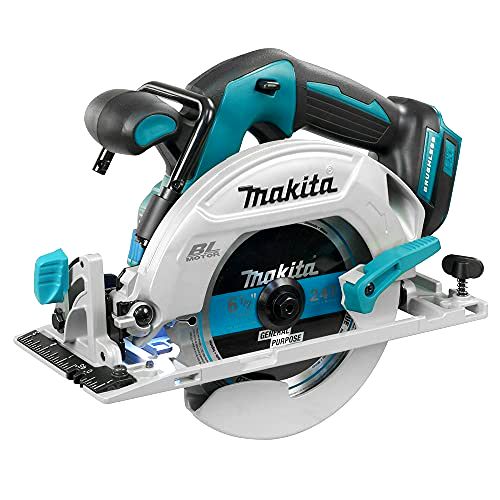
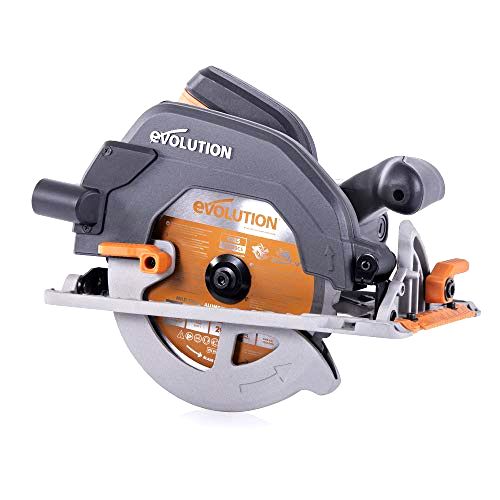
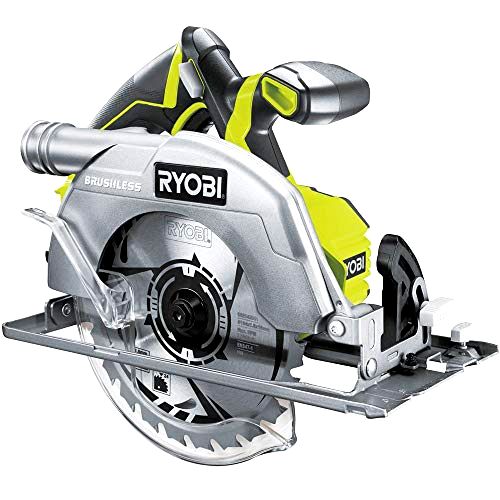
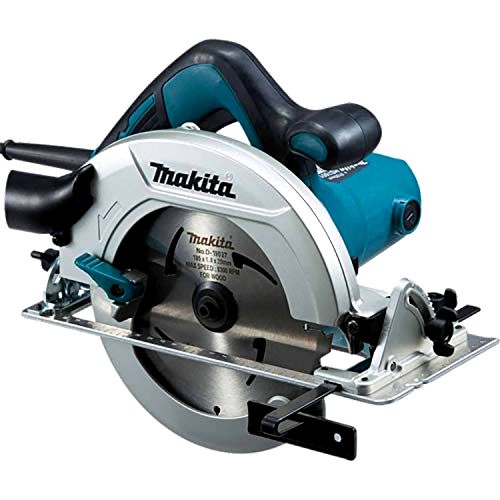


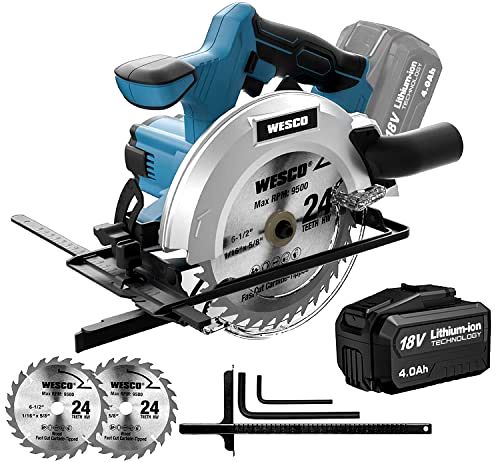
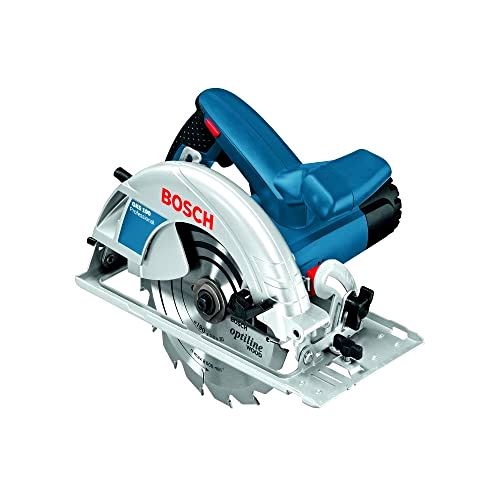

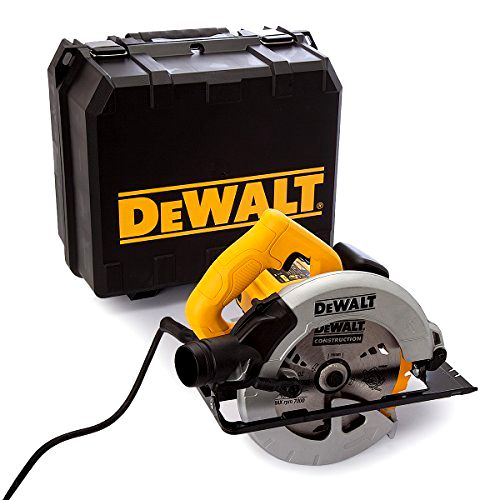
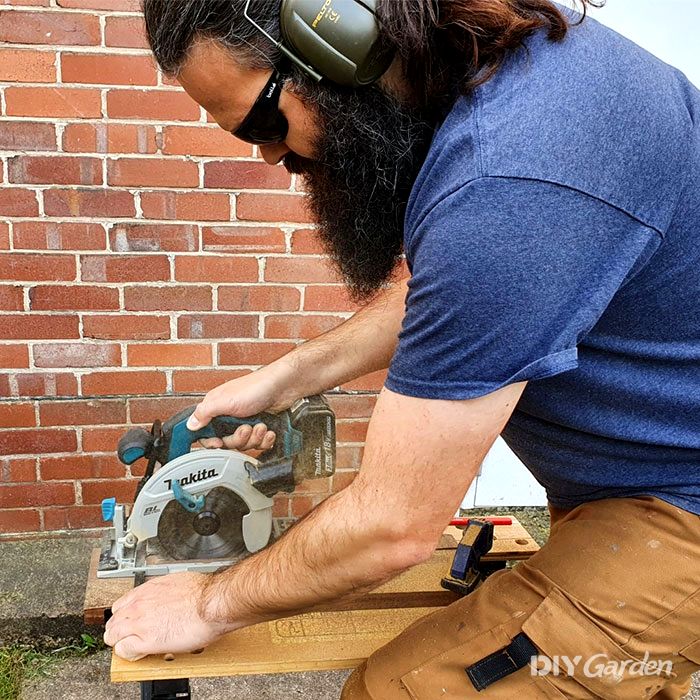

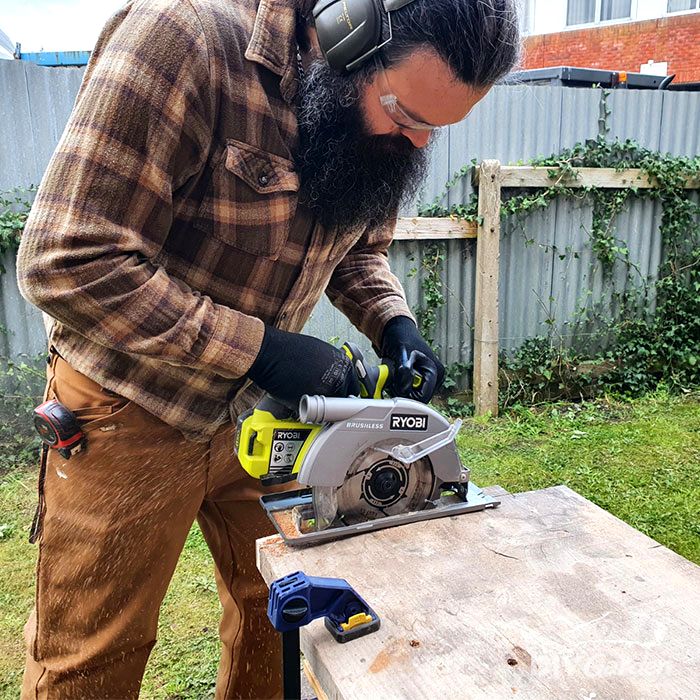
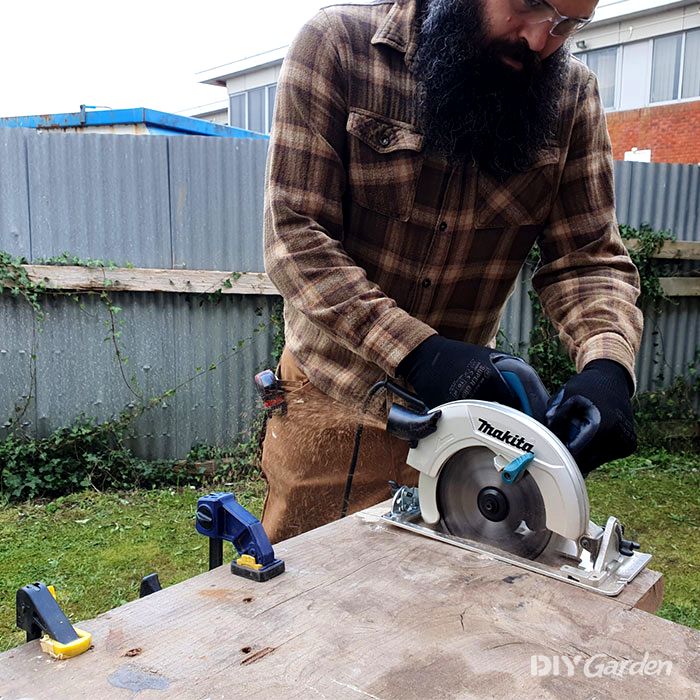


Share